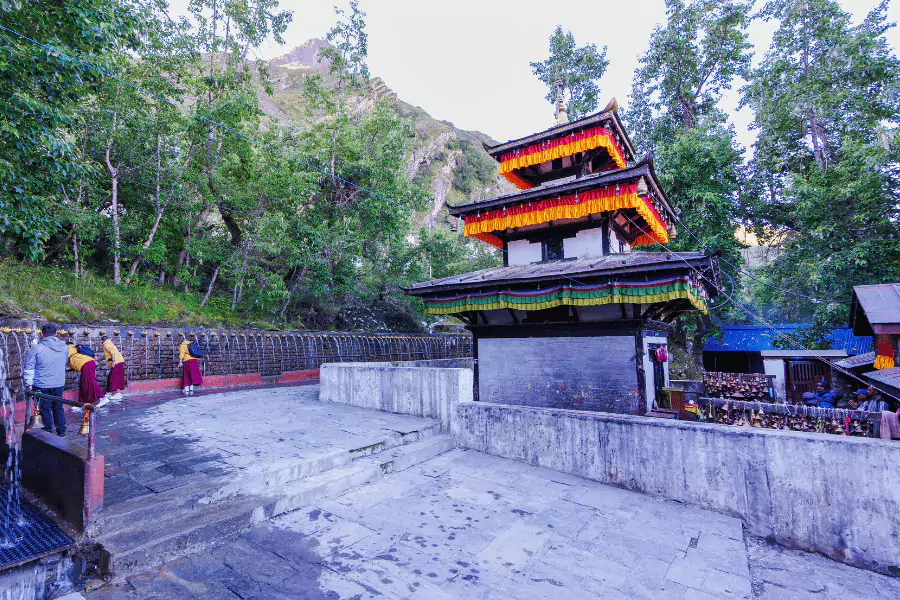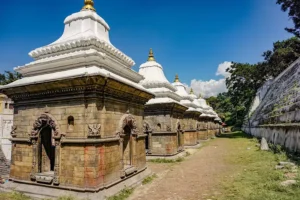Muktinath Temple
Muktinath Temple honors Lord Vishnu, one of Hinduism’s three principal deities. Vishnu serves as the preserver of the universe and returns in various incarnations to restore balance. Consequently, devotees travel from far and wide to pay their respects here.
At Muktinath, worship centers on the Shaligram Shila, a sacred fossilized stone regarded as a form of Vishnu. Legend says Vishnu once disguised himself to defeat a powerful demon. When that disguise led to Tulasi’s curse, Vishnu became Shaligram and later performed intense penance at this site. As a result, devotees view Muktinath as a place where Vishnu attained liberation. Moreover, Muktinath stands among the Eight Swayam Bhu (self-manifested) shrines of Vishnu and ranks as one of the 108 Divya Desams honored in Vaishnava tradition.
Queen Subarna Prabha Devi built the present pagoda-style temple around 1815 AD. Inside, a human-sized copper image of Vishnu sits in padmasana wearing yellow robes. To his right stands Saraswati (Bhu Devi) in red, and to his left stands Lakshmi (Shri Devi) in red. Also on display, caretakers keep idols of Ganesh, Garuda, Gautam Buddha, Alwar Acharya Shri Ramanuja, and many sacred Shaligram stones.
Meaning of the word Muktinath (Mukthinath)
In Sanskrit, “Mukti” means liberation or salvation, and “Nath” means lord or master. Put simply, Muktinath refers to the “Lord of Salvation.” Therefore, pilgrims who seek spiritual release frequently name this temple as a destination for Mukti.
What is special about Muktinath Temple?
High Altitude Temple
Muktinath ranks among the world’s highest temples, sitting at 3,710 meters (12,172 feet). Because thin air at altitude affects many visitors, you should acclimatize and plan carefully. Seniors, in particular, should consult a physician before undertaking the yatra.
Worshipped by two religions
Both Hindus and Buddhists revere Muktinath. Hindus call it Mukti Kshetra (place of salvation), while Buddhists refer to it as Chumig Gyatsa (hundred waters). Consequently, the site bridges traditions: Hindus honor Vishnu, and Buddhists treat the place as a powerful Tantric and meditative spot.
Presence of two different priests
Two priestly traditions serve the shrine. First, Hindu priests open the temple at dawn and perform the morning aarti. Then, they hand over daily care to Buddhist nuns (called Jhuma or Aani), who receive offerings throughout the day. Finally, Hindu priests return for the evening aarti and close the temple at night.
Surrounding Landscape
The temple sits beneath the soaring Annapurna and Dhaulagiri ranges. From the complex, visitors can see Dhaulagiri (the world’s seventh-highest peak), Tukuche, Nilgiri, Tilicho, and Muktinath Peak. Moreover, the stark, barren hills create dramatic scenery that filmmakers and music directors often choose as a backdrop.
One of the Char Dham of Nepal
Nepal recognizes four sacred dhams: Baraha Kshetra, Pashupat Kshetra, Mukti Kshetra, and Ruru Kshetra. Muktinath represents Mukti Kshetra, and many Hindus include it among the pilgrimage sites they aim to visit at least once.
Gandaki River Bathing
Behind the temple the Gandaki River flows continuously. River water pours through 108 cow-headed spouts, known as the 108 Mukti Dhara, and pilgrims bathe beneath these spouts believing the cold water helps wash away past sins and bad karma.
Why do people visit Muktinath?
Why do Vaishnavas visit Muktinath Temple?
Vaishnav pilgrims count Muktinath among the 108 Divya Desams. Of those Divya Desams, most lie in India and only one sits in Nepal—Muktinath. Therefore, many Vaishnav followers consider visiting Muktinath crucial to completing their spiritual circuit.
Why do Shaivas visit Muktinath?
Shaiva tradition regards this area as a Shakti Peetha. According to legend, a part of Sati Devi’s body fell here, and therefore Shaiva devotees visit the Mukteshwar Mahadev Temple within the complex to honor Shiva and Shakti.
Why do Buddhists visit Muktinath?
Followers of Guru Padmasambhava (Guru Rinpoche) count Muktinath among important Tantric meditation sites. Tradition holds that Padmasambhava meditated here and encountered Sky Dakinis; as a result, Buddhists consider the location rich in Tantric energy and meditative power.
Why do Swaminarayan sampradaya people visit Muktinath?
In the 18th century, Swaminarayan Nilkanth Varni performed intense penance at Muktinath, standing on one leg for 21 days. Thus, members of the Swaminarayan sampradaya honor that episode and include Muktinath in their pilgrimage routes.
Overall, pilgrims come to worship Vishnu, bathe in the 108 Mukti Dhara for purification, seek Mukti (liberation), and absorb the natural beauty of the surrounding Himalaya.
Historical importance of Muktinath Temple
Scriptures such as the Devi Bhagavata Purana, Brahma Vaivarta Purana, and Shiva Purana connect Muktinath to the tale of Tulasi and Shankhachuda. In that narrative, Shankhachuda gained power through his armor and Tulasi’s chastity, and he threatened the gods. To restore balance, Vishnu tricked Shankhachuda and caused his downfall. Afterward, Tulasi cursed Vishnu for the deception, and tradition says Vishnu became a Shaligram Shila. Accordingly, devotees believe Vishnu performed penance at Muktinath and later attained liberation. In addition, the story explains that Tulasi transformed into the Gandaki River, which still carries Shaligram stones in its current.
Where is Muktinath Temple located in map of Nepal?
Muktinath lies in Mustang District, Gandaki Province, roughly 197 km northwest of Pokhara. The temple perches at 3,710 meters near the Thorong-La Pass and forms an important stop on the Annapurna Circuit Trek.
Important Places to Visit in Muktinath
- Samba Gompa: A monastery honoring Shakyamuni, Chenrezig, and Guru Rinpoche.
- Muktinath Yagyashala: A hall where pilgrims perform yagnas and rituals.
- Vishnu Paduka: A meditation site where Swaminarayan Nilkanth Varni practiced.
- Mukteshwar Mahadev Temple: A Shiva–Parvati shrine regarded as a Shakti Peetha.
- 108 Mukti Dhara: The cow-headed spouts where pilgrims bathe for purification.
- Paap Kunda and Punya Kunda: Small ponds believed to wash away sins and increase virtue.
- Narshing Gompa: A monastery with a large clay image of Guru Rinpoche; Hindus often worship the figure as Narasimha.
- Jwala Mai Temple: A shrine with a continuous natural flame that observers consider miraculous.
How to reach Muktinath in Nepal?
Route I: Pokhara to Muktinath by Charter Helicopter
Charter helicopters fly from Pokhara and land near the temple in about 35 minutes. From the helipad you climb roughly 130 steps (about 10–15 minutes) to reach the shrine. If you cannot walk, porters (dholis) offer carrying services. Note that helicopters usually wait about an hour on-site.
Route II: Pokhara to Jomsom by regular flight and drive to Muktinath
Small planes shuttle from Pokhara to Jomsom in about 20 minutes. Then, private jeeps take roughly one hour to reach Ranipauwa (the Muktinath jeep station). From there, you hike about 45 minutes to the temple or hire horses and dholis.
Route III: Pokhara to Muktinath by adventurous 4-wheeler drive
A private jeep from Pokhara to Muktinath covers around 197 km and takes about eight hours. The road varies from smooth to rocky, and you can visit attractions such as Rupse Waterfall, Marpha Village, Kagbeni, and the Shaligram Museum along the way.
Route IV: Pokhara to Muktinath by Trekking
If you prefer trekking, start from Nayapul (about one hour from Pokhara) and walk through teahouses over 7–8 days. This option gives you a full Himalayan trekking experience with acclimatization built into the itinerary.
How to go to Muktinath from Kathmandu?
- Charter Helicopter: A direct charter takes about 1 hour 15 minutes and suits travelers with limited time; you can complete Muktinath darshan within a single day if needed.
- Drive by Private Jeep: Expect two days of scenic driving (8–9 hours per day). Because road work and rough sections remain common, this route suits able travelers who prefer overland travel.
- Fly via Pokhara & Jomsom: Fly from Kathmandu to Pokhara, then catch an early morning flight to Jomsom and drive to Muktinath. You should plan an overnight stay in Pokhara because Jomsom flights depart early.
What permits are required to visit Muktinath Temple?
Because Muktinath sits inside the Annapurna Conservation Area, you must obtain an ACAP Permit from Kathmandu or Pokhara. Officials check permits at Ghasa, Jomsom, and Muktinath; arriving without a permit can lead to on-the-spot fines. Fortunately, the government now issues online e-permits, which let you apply and pay remotely before departure.
Which is the best time to visit Muktinath?
Muktinath Temple stays open throughout the year, but the high-altitude location across the Annapurna Range makes weather a key factor for travelers. Choosing the right season ensures a safe and comfortable journey.
- Best months: The best months to visit are March, April, May, September, October, and November. During this period, the skies remain clear, temperatures are pleasant, and the mountain views are spectacular. These conditions make sightseeing and travel much easier.
- Monsoon season (June–August): June, July, and August bring heavy monsoon rains. Landslides are common in this season, and roads often get blocked. As a result, reaching Muktinath can become uncertain. Travelers may also face shortages of food and accommodation. For this reason, visiting during monsoon is not advisable.
- Winter season (December–February): The winter season is extremely cold. Temperatures often fall between -10°C and -15°C. This time is perfect for visitors who want to see snowfall, but the harsh weather demands proper preparation. Carrying heavy woolens and warm gear is essential for a comfortable trip.



